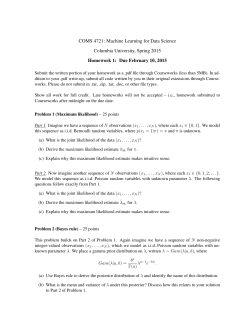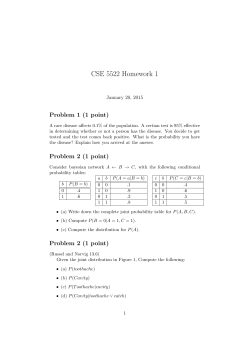
Mixture Models and the EM algorithm
Mixture Models and the EM Algorithm Alan Ritter Latent Variable Models • Previously: learning parameters with fully observed data • Alternate approach: hidden (latent) variables Latent Cause Q: how do we learn parameters? Unsupervised Learning • Also known as clustering • What if we just have a bunch of data, without any labels? • Also computes compressed representation of the data Mixture models: Generative Story 1. Repeat: 1. Choose a component according to P(Z) 2. Generate the X as a sample from P(X|Z) • We may have some synthetic data that was generated in this way. • Unlikely any real-world data follows this procedure. Mixture Models • Objective function: log likelihood of data • Naïve Bayes: • Gaussian Mixture Model (GMM) – is multivariate Gaussian • Base distributions, ,can be pretty much anything Previous Lecture: Fully Observed Data • Finding ML parameters was easy – Parameters for each CPT are independent Learning with latent variables is hard! • Previously, observed all variables during parameter estimation (learning) – This made parameter learning relatively easy – Can estimate parameters independently given data – Closed-form solution for ML parameters Mixture models (plate notation) Gaussian Mixture Models (mixture of Gaussians) • A natural choice for continuous data • Parameters: – Component weights – Mean of each component – Covariance of each component GMM Parameter Estimation 1 1 1 0.8 0.8 0.8 0.6 0.6 0.6 0.4 0.4 0.4 0.2 0.2 0.2 0 0 0 0.2 0.4 0.6 0.8 1 0 0 0.2 0.4 0.6 0.8 1 0 0.2 0.4 0.6 0.8 1 Q: how can we learn parameters? • Chicken and egg problem: – If we knew which component generated each datapoint it would be easy to recover the component Gaussians – If we knew the parameters of each component, we could infer a distribution over components to each datapoint. • Problem: we know neither the assignments nor the parameters EM for M ixt ur es of G aussians I nit ializat ion: Choose means at random, et c. E st ep: For all examples x k : P (µ i |x k ) = P (µ i )P (x k |µ i ) = P (x k ) P (µ i )P (x k |µ i ) P (µ i ′ )P (x k |µ i ′ ) i′ M st ep: For all component s ci : P (ci ) = µi = σi2 = 1 ne ne P (µ i |x k ) k= 1 ne x P (µ i |x k ) k= 1 k ne P (µ i |x k ) k= 1 ne 2 (x − µ ) P (µ i i k k= 1 ne P (µ i |x k ) k= 1 |x k ) 2 0 −2 −2 0 2 Why does EM work? • Monotonically increases observed data likelihood until it reaches a local maximum EM is more general than GMMs • Can be applied to pretty much any probabilistic model with latent variables • Not guaranteed to find the global optimum – Random restarts – Good initialization Important Notes For the HW • Likelihood is always guaranteed to increase. – If not, there is a bug in your code – (this is useful for debugging) • A good idea to work with log probabilities – See log identities http://en.wikipedia.org/wiki/List_of_logarithmic_iden tities • Problem: Sums of logs – No immediately obvious way to compute – Need to convert back from log-space to sum? – NO! Use the log-exp-sum trick! Numerical Issues • Example Problem: multiplying lots of probabilities (e.g. when computing likelihood) • In some cases we also need to sum probabilities – No log identity for sums – Q: what can we do? Log Exp Sum Trick: motivation • We have: a bunch of log probabilities. – log(p1), log(p2), log(p3), … log(pn) • We want: log(p1 + p2 + p3 + … pn) • We could convert back from log space, sum then take the log. – If the probabilities are very small, this will result in floating point underflow Log Exp Sum Trick: K-means Algorithm • Hard EM • Maximizing a different objective function (not likelihood)
© Copyright 2025





















